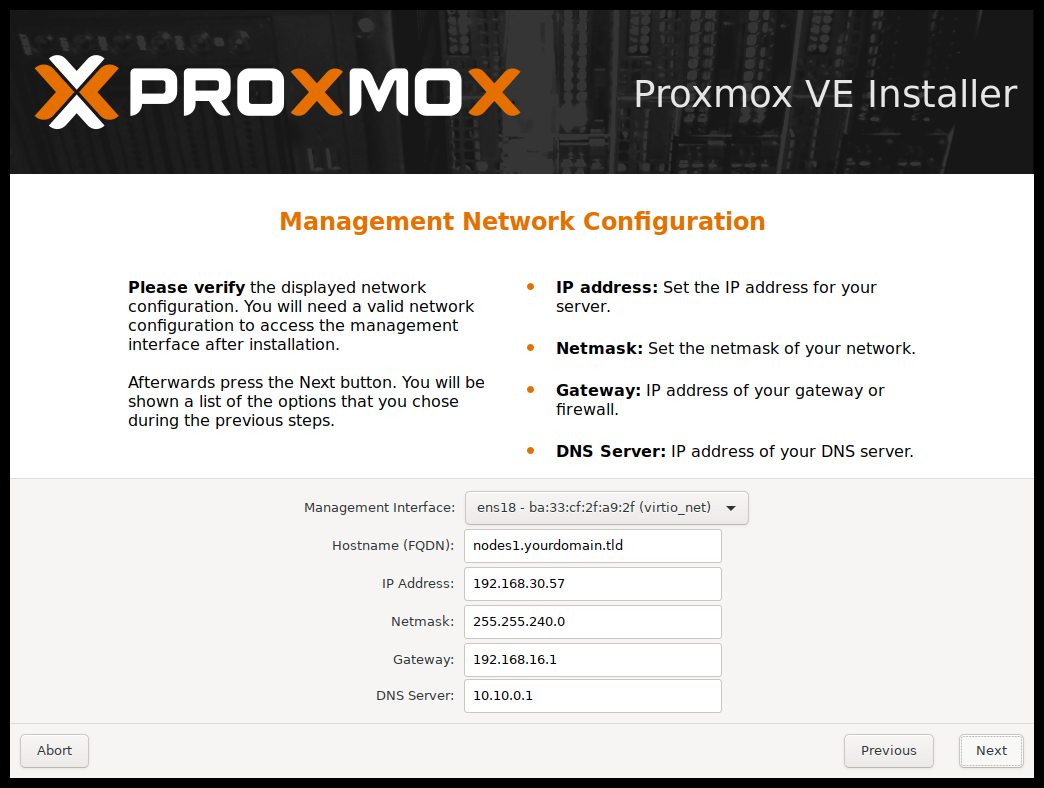Difference between revisions of "Installation"
| (108 intermediate revisions by 24 users not shown) | |||
| Line 1: | Line 1: | ||
| − | + | <!--PVE_IMPORT_START_MARKER--> | |
| − | Proxmox VE installs the | + | <!-- Do not edit - this is autogenerated content --> |
| + | {{#pvedocs:pve-installation-plain.html}} | ||
| + | [[Category:Reference Documentation]] | ||
| + | <pvehide> | ||
| + | Proxmox VE is based on Debian. This is why the install disk images (ISO files) | ||
| + | provided by Proxmox include a complete Debian system (Debian 10 Buster for | ||
| + | Proxmox VE version 6.x) as well as all necessary Proxmox VE packages. | ||
| + | The installer will guide through the setup, allowing you to partition the local | ||
| + | disk(s), apply basic system configurations (for example, timezone, language, | ||
| + | network) and install all required packages. This process should not take more | ||
| + | than a few minutes. Installing with the provided ISO is the recommended method | ||
| + | for new and existing users. | ||
| + | Alternatively, Proxmox VE can be installed on top of an existing Debian system. This | ||
| + | option is only recommended for advanced users because detailed knowledge about | ||
| + | Proxmox VE is required. | ||
| + | Using the Proxmox VE Installer | ||
| + | The installer ISO image includes the following: | ||
| + | Complete operating system (Debian Linux, 64-bit) | ||
| + | The Proxmox VE installer, which partitions the local disk(s) with ext4, ext3, xfs | ||
| + | or ZFS and installs the operating system. | ||
| + | Proxmox VE Linux kernel with KVM and LXC support | ||
| + | Complete toolset for administering virtual machines, containers, the host | ||
| + | system, clusters and all necessary resources | ||
| + | Web-based management interface | ||
| + | All existing data on the for installation selected drives will be removed | ||
| + | during the installation process. The installer does not add boot menu entries | ||
| + | for other operating systems. | ||
| + | Please insert the prepared installation media | ||
| + | (for example, USB flash drive or CD-ROM) and boot from it. | ||
| + | Make sure that booting from the installation medium (for example, USB) is | ||
| + | enabled in your servers firmware settings. | ||
| + | After choosing the correct entry (e.g. Boot from USB) the Proxmox VE menu will be | ||
| + | displayed and one of the following options can be selected: | ||
| + | Install Proxmox VE | ||
| + | Starts the normal installation. | ||
| + | It’s possible to use the installation wizard with a keyboard only. Buttons | ||
| + | can be clicked by pressing the ALT key combined with the underlined character | ||
| + | from the respective button. For example, ALT + N to press a Next button. | ||
| + | Install Proxmox VE (Debug mode) | ||
| + | Starts the installation in debug mode. A console will be opened at several | ||
| + | installation steps. This helps to debug the situation if something goes wrong. | ||
| + | To exit a debug console, press CTRL-D. This option can be used to boot a live | ||
| + | system with all basic tools available. You can use it, for example, to | ||
| + | repair a degraded ZFS rpool or fix the | ||
| + | bootloader for an existing Proxmox VE setup. | ||
| + | Rescue Boot | ||
| + | With this option you can boot an existing installation. It searches all attached | ||
| + | hard disks. If it finds an existing installation, it boots directly into that | ||
| + | disk using the Linux kernel from the ISO. This can be useful if there are | ||
| + | problems with the boot block (grub) or the BIOS is unable to read the boot block | ||
| + | from the disk. | ||
| + | Test Memory | ||
| + | Runs memtest86+. This is useful to check if the memory is functional and free | ||
| + | of errors. | ||
| + | After selecting Install Proxmox VE and accepting the EULA, the prompt to select the | ||
| + | target hard disk(s) will appear. The Options button opens the dialog to select | ||
| + | the target file system. | ||
| + | The default file system is ext4. The Logical Volume Manager (LVM) is used when | ||
| + | ext3, ext4 or xfs ist selected. Additional options to restrict LVM space | ||
| + | can be set (see below). | ||
| + | Proxmox VE can be installed on ZFS. As ZFS offers several software RAID levels, this | ||
| + | is an option for systems that don’t have a hardware RAID controller. The target | ||
| + | disks must be selected in the Options dialog. More ZFS specific settings can | ||
| + | be changed under Advanced Options (see below). | ||
| + | ZFS on top of any hardware RAID is not supported and can result in data | ||
| + | loss. | ||
| + | The next page asks for basic configuration options like the location, the time | ||
| + | zone, and keyboard layout. The location is used to select a download server | ||
| + | close by to speed up updates. The installer usually auto-detects these settings. | ||
| + | They only need to be changed in the rare case that auto detection fails or a | ||
| + | different keyboard layout should be used. | ||
| + | Next the password of the superuser (root) and an email address needs to be | ||
| + | specified. The password must consist of at least 5 characters. It’s highly | ||
| + | recommended to use a stronger password. Some guidelines are: | ||
| + | Use a minimum password length of 12 to 14 characters. | ||
| + | Include lowercase and uppercase alphabetic characters, numbers, and symbols. | ||
| + | Avoid character repetition, keyboard patterns, common dictionary words, | ||
| + | letter or number sequences, usernames, relative or pet names, romantic links | ||
| + | (current or past), and biographical information (for example ID numbers, | ||
| + | ancestors' names or dates). | ||
| + | The email address is used to send notifications to the system administrator. | ||
| + | For example: | ||
| + | Information about available package updates. | ||
| + | Error messages from periodic CRON jobs. | ||
| + | The last step is the network configuration. Please note that during installation | ||
| + | you can either use an IPv4 or IPv6 address, but not both. To configure a dual | ||
| + | stack node, add additional IP addresses after the installation. | ||
| + | The next step shows a summary of the previously selected options. Re-check every | ||
| + | setting and use the Previous button if a setting needs to be changed. To | ||
| + | accept, press Install. The installation starts to format disks and copies | ||
| + | packages to the target. Please wait until this step has finished; then remove | ||
| + | the installation medium and restart your system. | ||
| + | If the installation failed check out specific errors on the second TTY | ||
| + | (‘CTRL + ALT + F2’), ensure that the systems meets the | ||
| + | minimum requirements. If the installation | ||
| + | is still not working look at the how to get help chapter. | ||
| + | Further configuration is done via the Proxmox web interface. Point your browser | ||
| + | to the IP address given during installation (https://youripaddress:8006). | ||
| + | Default login is "root" (realm PAM) and the root password is defined | ||
| + | during the installation process. | ||
| + | Advanced LVM Configuration Options | ||
| + | The installer creates a Volume Group (VG) called pve, and additional Logical | ||
| + | Volumes (LVs) called root, data, and swap. To control the size of these | ||
| + | volumes use: | ||
| + | hdsize | ||
| + | Defines the total hard disk size to be used. This way you can reserve free space | ||
| + | on the hard disk for further partitioning (for example for an additional PV and | ||
| + | VG on the same hard disk that can be used for LVM storage). | ||
| + | swapsize | ||
| + | Defines the size of the swap volume. The default is the size of the installed | ||
| + | memory, minimum 4 GB and maximum 8 GB. The resulting value cannot be greater | ||
| + | than hdsize/8. | ||
| + | If set to 0, no swap volume will be created. | ||
| + | maxroot | ||
| + | Defines the maximum size of the root volume, which stores the operation | ||
| + | system. The maximum limit of the root volume size is hdsize/4. | ||
| + | maxvz | ||
| + | Defines the maximum size of the data volume. The actual size of the data | ||
| + | volume is: | ||
| + | datasize = hdsize - rootsize - swapsize - minfree | ||
| + | Where datasize cannot be bigger than maxvz. | ||
| + | In case of LVM thin, the data pool will only be created if datasize is | ||
| + | bigger than 4GB. | ||
| + | If set to 0, no data volume will be created and the storage | ||
| + | configuration will be adapted accordingly. | ||
| + | minfree | ||
| + | Defines the amount of free space left in the LVM volume group pve. With more | ||
| + | than 128GB storage available the default is 16GB, else hdsize/8 will be used. | ||
| + | LVM requires free space in the VG for snapshot creation (not required for | ||
| + | lvmthin snapshots). | ||
| + | Advanced ZFS Configuration Options | ||
| + | The installer creates the ZFS pool rpool. No swap space is created but you can | ||
| + | reserve some unpartitioned space on the install disks for swap. You can also | ||
| + | create a swap zvol after the installation, although this can lead to problems. | ||
| + | (see ZFS swap notes). | ||
| + | ashift | ||
| + | Defines the ashift value for the created pool. The ashift needs to be set at | ||
| + | least to the sector-size of the underlying disks (2 to the power of ashift is | ||
| + | the sector-size), or any disk which might be put in the pool (for example the | ||
| + | replacement of a defective disk). | ||
| + | compress | ||
| + | Defines whether compression is enabled for rpool. | ||
| + | checksum | ||
| + | Defines which checksumming algorithm should be used for rpool. | ||
| + | copies | ||
| + | Defines the copies parameter for rpool. Check the zfs(8) manpage for the | ||
| + | semantics, and why this does not replace redundancy on disk-level. | ||
| + | hdsize | ||
| + | Defines the total hard disk size to be used. This is useful to save free space | ||
| + | on the hard disk(s) for further partitioning (for example to create a | ||
| + | swap-partition). hdsize is only honored for bootable disks, that is only the | ||
| + | first disk or mirror for RAID0, RAID1 or RAID10, and all disks in RAID-Z[123]. | ||
| + | ZFS Performance Tips | ||
| + | ZFS works best with a lot of memory. If you intend to use ZFS make sure to have | ||
| + | enough RAM available for it. A good calculation is 4GB plus 1GB RAM for each TB | ||
| + | RAW disk space. | ||
| + | ZFS can use a dedicated drive as write cache, called the ZFS Intent Log (ZIL). | ||
| + | Use a fast drive (SSD) for it. It can be added after installation with the | ||
| + | following command: | ||
| + | # zpool add <pool-name> log </dev/path_to_fast_ssd> | ||
| + | Prepare Installation Media | ||
| + | link:/wiki/Install_Proxmox_VE_on_Debian_Buster[Install Proxmox VE on Debian Buster] | ||
| + | Video Tutorials | ||
| + | List of all official tutorials on our | ||
| + | Proxmox VE YouTube Channel | ||
| + | Tutorials in Spanish language on | ||
| + | ITexperts.es | ||
| + | YouTube Play List | ||
| + | See Also | ||
| + | System Requirements | ||
| + | Package Repositories | ||
| + | Host System Administration | ||
| + | Network Configuration | ||
| + | Installation: Tips and Tricks | ||
| + | </pvehide> | ||
| + | <!--PVE_IMPORT_END_MARKER--> | ||
| − | |||
| − | + | [[Category:HOWTO]] [[Category:Installation]] | |
| − | |||
| − | |||
| − | |||
| − | |||
| − | |||
| − | |||
| − | |||
| − | |||
| − | |||
| − | |||
| − | |||
| − | |||
| − | |||
| − | |||
| − | |||
| − | |||
| − | |||
| − | |||
| − | |||
| − | |||
| − | |||
| − | |||
| − | |||
| − | |||
| − | |||
| − | |||
| − | |||
| − | |||
| − | |||
| − | |||
| − | |||
| − | |||
| − | |||
| − | |||
| − | |||
| − | |||
| − | |||
| − | |||
| − | |||
| − | |||
| − | |||
| − | |||
| − | |||
| − | |||
| − | |||
| − | |||
| − | |||
| − | |||
| − | |||
| − | |||
| − | |||
| − | |||
| − | |||
| − | |||
| − | |||
| − | |||
| − | |||
| − | |||
| − | |||
| − | |||
| − | |||
| − | |||
| − | |||
| − | |||
| − | |||
| − | |||
| − | |||
| − | |||
| − | |||
| − | |||
| − | |||
| − | |||
| − | |||
| − | |||
| − | |||
| − | |||
| − | |||
| − | |||
| − | |||
| − | |||
| − | |||
| − | |||
| − | |||
| − | |||
| − | |||
| − | |||
| − | |||
| − | |||
| − | |||
| − | |||
| − | |||
| − | |||
| − | |||
| − | |||
| − | |||
| − | |||
| − | |||
| − | |||
| − | |||
| − | |||
| − | |||
| − | |||
| − | |||
| − | |||
| − | |||
| − | |||
| − | |||
| − | |||
| − | |||
| − | |||
| − | |||
| − | |||
| − | |||
| − | |||
| − | |||
| − | |||
| − | |||
| − | |||
| − | |||
| − | |||
| − | |||
| − | |||
| − | |||
| − | |||
| − | |||
| − | |||
| − | |||
| − | |||
| − | |||
| − | |||
| − | |||
| − | |||
| − | |||
| − | |||
| − | |||
| − | |||
| − | |||
| − | |||
| − | |||
| − | |||
| − | |||
| − | |||
| − | |||
| − | |||
| − | |||
| − | |||
| − | |||
| − | |||
| − | |||
| − | |||
| − | |||
| − | |||
| − | |||
| − | |||
| − | |||
| − | |||
| − | |||
| − | |||
| − | |||
| − | |||
| − | |||
| − | |||
| − | |||
| − | |||
| − | |||
| − | |||
| − | |||
| − | |||
| − | |||
| − | |||
| − | |||
| − | [[Category: HOWTO]][[Category: Installation]] | ||
| − | |||
| − | |||
| − | |||
| − | |||
| − | |||
| − | |||
| − | |||
| − | |||
| − | |||
| − | |||
| − | |||
| − | |||
| − | |||
| − | |||
| − | |||
| − | |||
| − | |||
| − | |||
| − | |||
| − | |||
| − | |||
| − | |||
| − | |||
| − | |||
| − | |||
| − | |||
| − | |||
| − | |||
Revision as of 13:54, 21 February 2020
Proxmox VE is based on Debian. This is why the install disk images (ISO files) provided by Proxmox include a complete Debian system as well as all necessary Proxmox VE packages.
|
|
See the support table in the FAQ for the relationship between Proxmox VE releases and Debian releases. |
The installer will guide you through the setup, allowing you to partition the local disk(s), apply basic system configurations (for example, timezone, language, network) and install all required packages. This process should not take more than a few minutes. Installing with the provided ISO is the recommended method for new and existing users.
Alternatively, Proxmox VE can be installed on top of an existing Debian system. This option is only recommended for advanced users because detailed knowledge about Proxmox VE is required.
Using the Proxmox VE Installer
The installer ISO image includes the following:
-
Complete operating system (Debian Linux, 64-bit)
-
The Proxmox VE installer, which partitions the local disk(s) with ext4, XFS, BTRFS (technology preview), or ZFS and installs the operating system
-
Proxmox VE Linux kernel with KVM and LXC support
-
Complete toolset for administering virtual machines, containers, the host system, clusters and all necessary resources
-
Web-based management interface
|
|
All existing data on the selected drives will be removed during the installation process. The installer does not add boot menu entries for other operating systems. |
Please insert the prepared installation media (for example, USB flash drive or CD-ROM) and boot from it.
|
|
Make sure that booting from the installation medium (for example, USB) is enabled in your server’s firmware settings. Secure boot needs to be disabled when booting an installer prior to Proxmox VE version 8.1. |
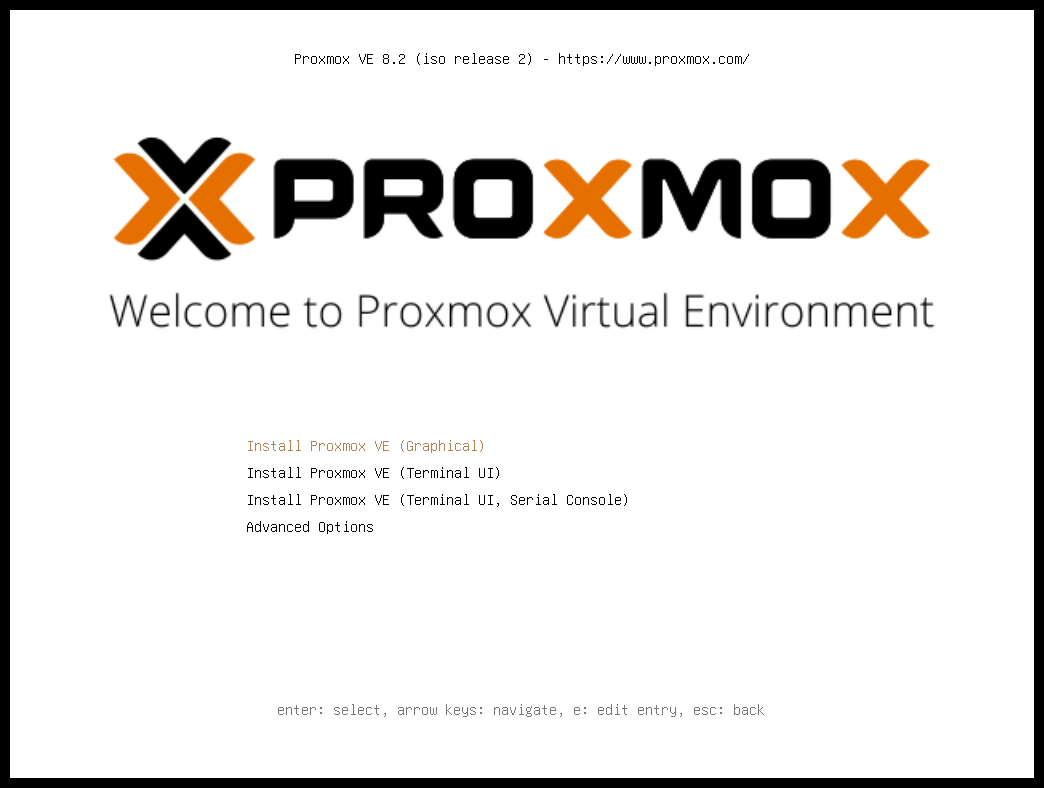
After choosing the correct entry (for example, Boot from USB) the Proxmox VE menu will be displayed, and one of the following options can be selected:
- Install Proxmox VE (Graphical)
-
Starts the normal installation.
|
|
It’s possible to use the installation wizard with a keyboard only. Buttons can be clicked by pressing the ALT key combined with the underlined character from the respective button. For example, ALT + N to press a Next button. |
- Install Proxmox VE (Terminal UI)
-
Starts the terminal-mode installation wizard. It provides the same overall installation experience as the graphical installer, but has generally better compatibility with very old and very new hardware.
- Install Proxmox VE (Terminal UI, Serial Console)
-
Starts the terminal-mode installation wizard, additionally setting up the Linux kernel to use the (first) serial port of the machine for in- and output. This can be used if the machine is completely headless and only has a serial console available.
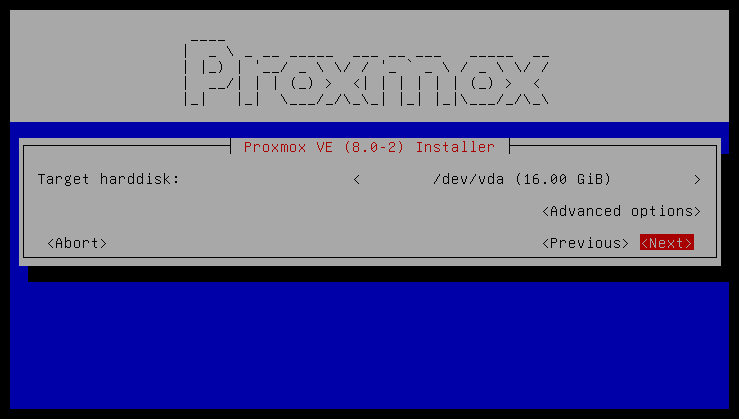
Both modes use the same code base for the actual installation process to benefit from more than a decade of bug fixes and ensure feature parity.
|
|
The Terminal UI option can be used in case the graphical installer does not work correctly, due to e.g. driver issues. See also adding the nomodeset kernel parameter. |
- Advanced Options: Install Proxmox VE (Graphical, Debug Mode)
-
Starts the installation in debug mode. A console will be opened at several installation steps. This helps to debug the situation if something goes wrong. To exit a debug console, press CTRL-D. This option can be used to boot a live system with all basic tools available. You can use it, for example, to repair a degraded ZFS rpool or fix the bootloader for an existing Proxmox VE setup.
- Advanced Options: Install Proxmox VE (Terminal UI, Debug Mode)
-
Same as the graphical debug mode, but preparing the system to run the terminal-based installer instead.
- Advanced Options: Install Proxmox VE (Serial Console Debug Mode)
-
Same the terminal-based debug mode, but additionally sets up the Linux kernel to use the (first) serial port of the machine for in- and output.
- Advanced Options: Rescue Boot
-
With this option you can boot an existing installation. It searches all attached hard disks. If it finds an existing installation, it boots directly into that disk using the Linux kernel from the ISO. This can be useful if there are problems with the bootloader (GRUB/systemd-boot) or the BIOS/UEFI is unable to read the boot block from the disk.
- Advanced Options: Test Memory (memtest86+)
-
Runs memtest86+. This is useful to check if the memory is functional and free of errors. Secure Boot must be turned off in the UEFI firmware setup utility to run this option.
You normally select Install Proxmox VE (Graphical) to start the installation.
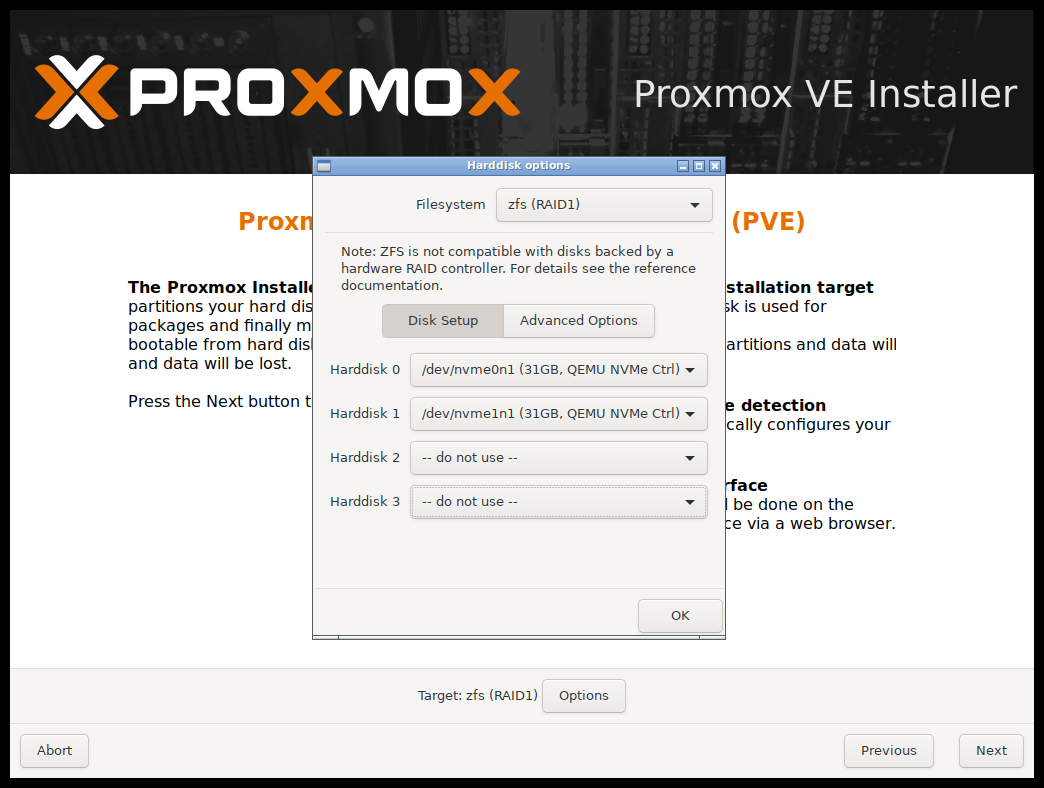
The first step is to read our EULA (End User License Agreement). Following this, you can select the target hard disk(s) for the installation.
|
|
By default, the whole server is used and all existing data is removed. Make sure there is no important data on the server before proceeding with the installation. |
The Options button lets you select the target file system, which defaults to ext4. The installer uses LVM if you select ext4 or xfs as a file system, and offers additional options to restrict LVM space (see below).
Proxmox VE can also be installed on ZFS. As ZFS offers several software RAID levels, this is an option for systems that don’t have a hardware RAID controller. The target disks must be selected in the Options dialog. More ZFS specific settings can be changed under Advanced Options.
|
|
ZFS on top of any hardware RAID is not supported and can result in data loss. |
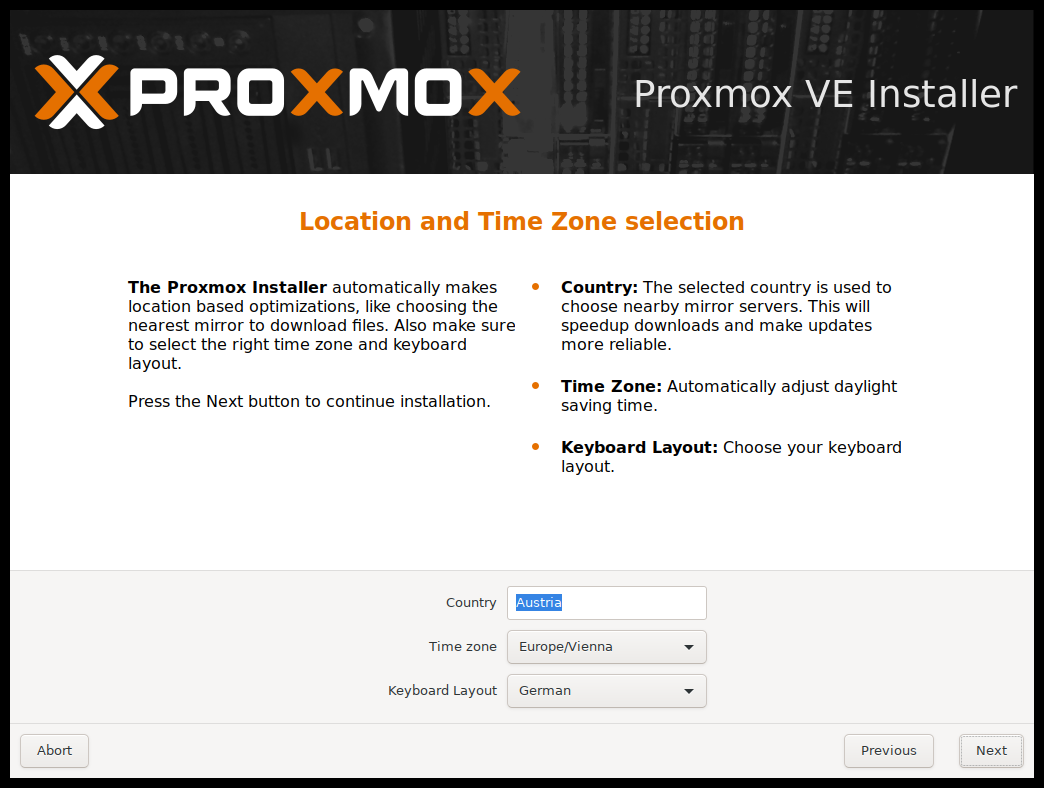
The next page asks for basic configuration options like your location, time zone, and keyboard layout. The location is used to select a nearby download server, in order to increase the speed of updates. The installer is usually able to auto-detect these settings, so you only need to change them in rare situations when auto-detection fails, or when you want to use a keyboard layout not commonly used in your country.
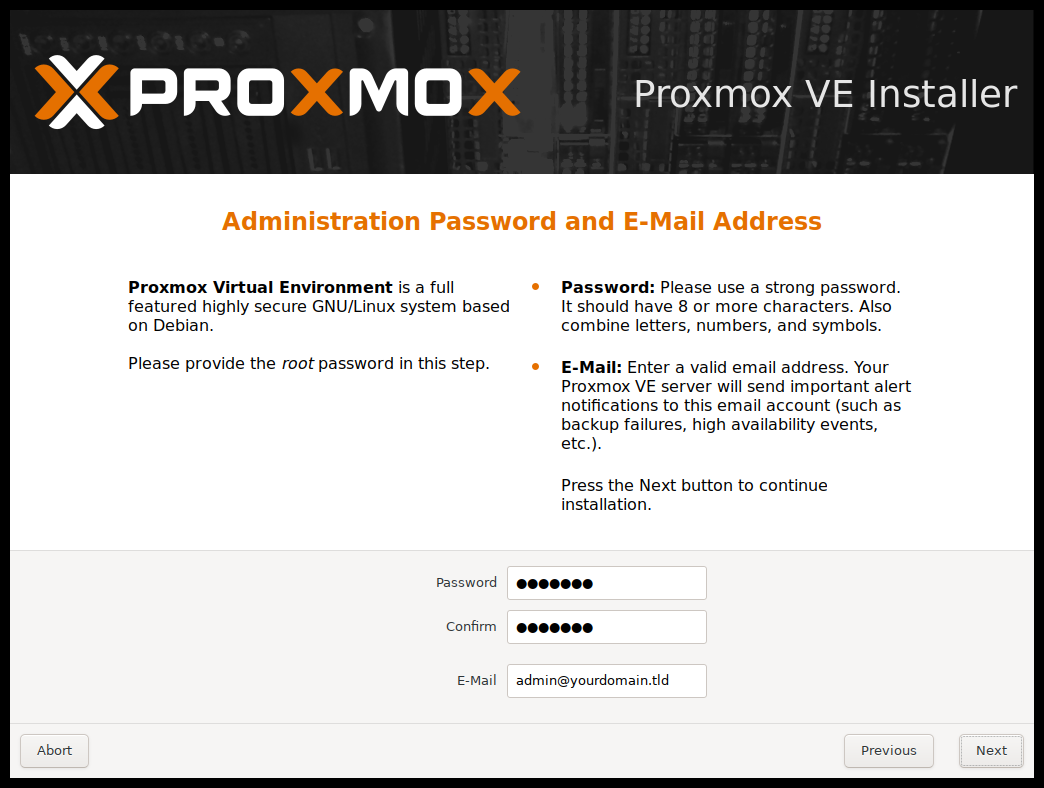
Next the password of the superuser (root) and an email address needs to be specified. The password must consist of at least 5 characters. It’s highly recommended to use a stronger password. Some guidelines are:
-
Use a minimum password length of at least 12 characters.
-
Include lowercase and uppercase alphabetic characters, numbers, and symbols.
-
Avoid character repetition, keyboard patterns, common dictionary words, letter or number sequences, usernames, relative or pet names, romantic links (current or past), and biographical information (for example ID numbers, ancestors' names or dates).
The email address is used to send notifications to the system administrator. For example:
-
Information about available package updates.
-
Error messages from periodic cron jobs.
The last step is the network configuration. Network interfaces that are UP show a filled circle in front of their name in the drop down menu. Please note that during installation you can either specify an IPv4 or IPv6 address, but not both. To configure a dual stack node, add additional IP addresses after the installation.
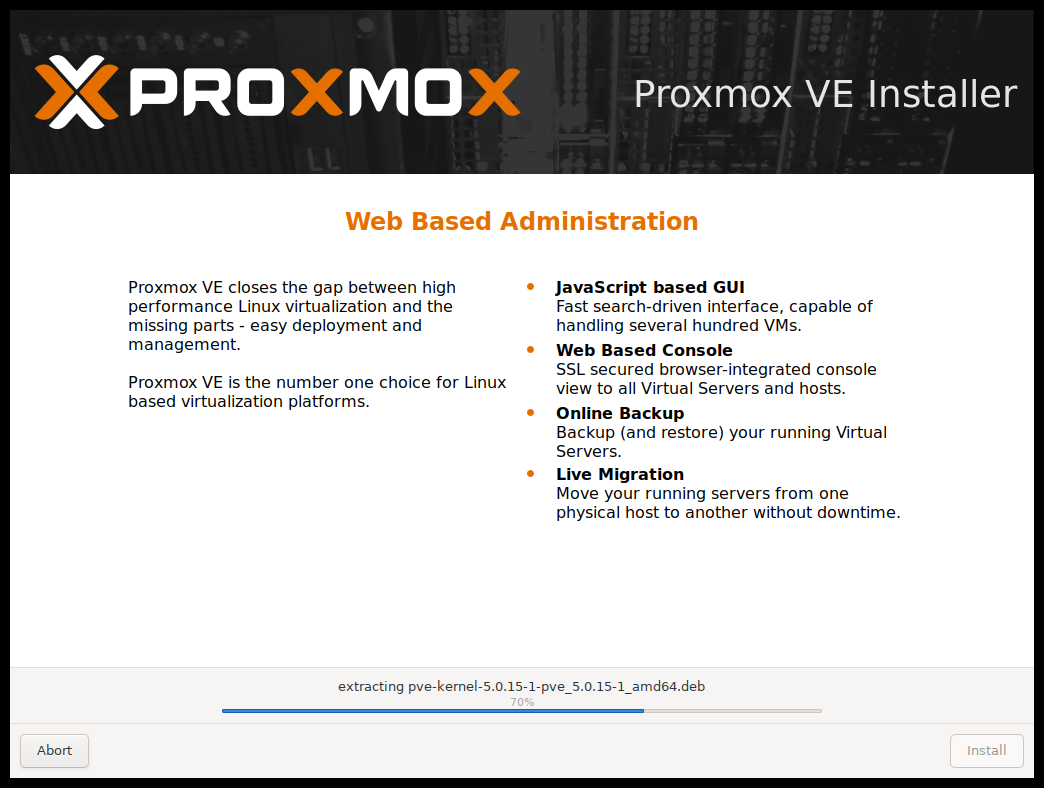
The next step shows a summary of the previously selected options. Please re-check every setting and use the Previous button if a setting needs to be changed.
After clicking Install, the installer will begin to format the disks and copy packages to the target disk(s). Please wait until this step has finished; then remove the installation medium and restart your system.
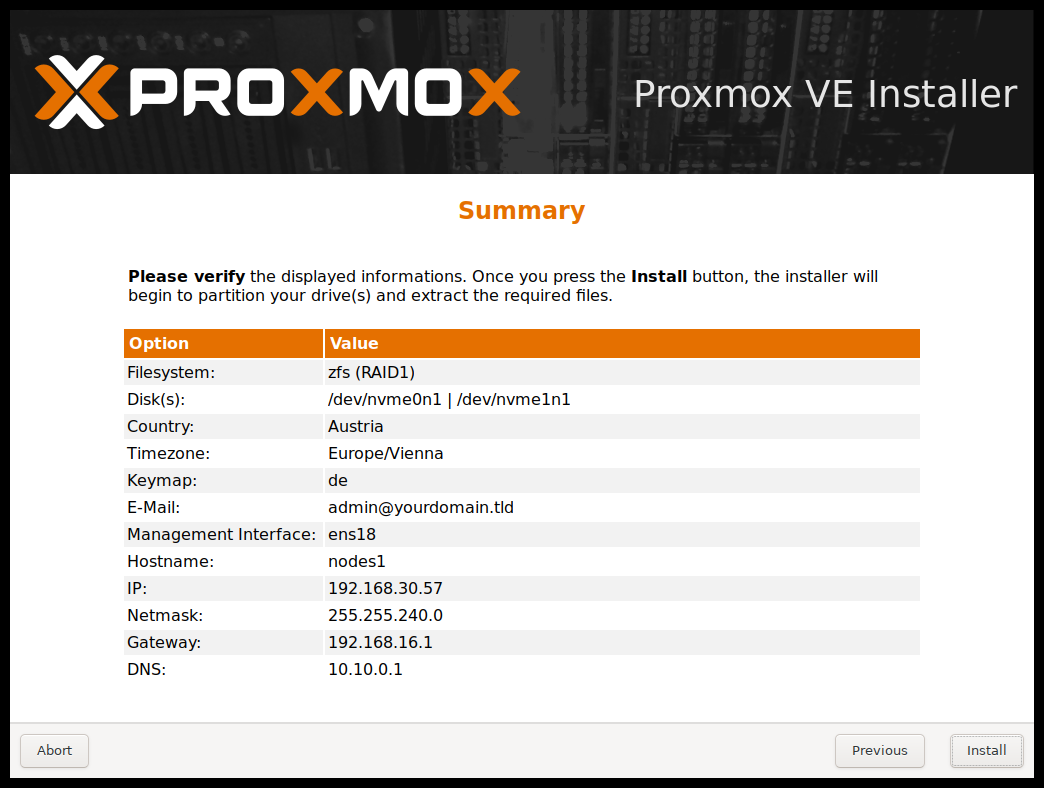
Copying the packages usually takes several minutes, mostly depending on the speed of the installation medium and the target disk performance.
When copying and setting up the packages has finished, you can reboot the server. This will be done automatically after a few seconds by default.
Installation Failure
If the installation failed, check out specific errors on the second TTY (CTRL + ALT + F2) and ensure that the systems meets the minimum requirements.
If the installation is still not working, look at the how to get help chapter.
Accessing the Management Interface Post-Installation
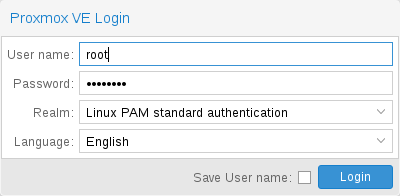
After a succesful installation and reboot of the system you can use the Proxmox VE web interface for further configuration.
-
Point your browser to the IP address given during the installation and port 8006, for example: https://youripaddress:8006
-
Log in using the root (realm PAM) username and the password chosen during installation.
-
Upload your subscription key to gain access to the Enterprise repository. Otherwise, you will need to set up one of the public, less tested package repositories to get updates for security fixes, bug fixes, and new features.
-
Check the IP configuration and hostname.
-
Check the timezone.
-
Check your Firewall settings.
Advanced LVM Configuration Options
The installer creates a Volume Group (VG) called pve, and additional Logical Volumes (LVs) called root, data, and swap, if ext4 or xfs is used. To control the size of these volumes use:
- hdsize
-
Defines the total hard disk size to be used. This way you can reserve free space on the hard disk for further partitioning (for example for an additional PV and VG on the same hard disk that can be used for LVM storage).
- swapsize
-
Defines the size of the swap volume. The default is the size of the installed memory, minimum 4 GB and maximum 8 GB. The resulting value cannot be greater than hdsize/8.
If set to 0, no swap volume will be created. - maxroot
-
Defines the maximum size of the root volume, which stores the operation system. The maximum limit of the root volume size is hdsize/4.
- maxvz
-
Defines the maximum size of the data volume. The actual size of the data volume is:
datasize = hdsize - rootsize - swapsize - minfree
Where datasize cannot be bigger than maxvz.
In case of LVM thin, the data pool will only be created if datasize is bigger than 4GB. If set to 0, no data volume will be created and the storage configuration will be adapted accordingly. - minfree
-
Defines the amount of free space that should be left in the LVM volume group pmg. With more than 128GB storage available, the default is 16GB, otherwise hdsize/8 will be used.
LVM requires free space in the VG for snapshot creation (not required for lvmthin snapshots).
Advanced ZFS Configuration Options
The installer creates the ZFS pool rpool, if ZFS is used. No swap space is created but you can reserve some unpartitioned space on the install disks for swap. You can also create a swap zvol after the installation, although this can lead to problems (see ZFS swap notes).
- ashift
-
Defines the ashift value for the created pool. The ashift needs to be set at least to the sector-size of the underlying disks (2 to the power of ashift is the sector-size), or any disk which might be put in the pool (for example the replacement of a defective disk).
- compress
-
Defines whether compression is enabled for rpool.
- checksum
-
Defines which checksumming algorithm should be used for rpool.
- copies
-
Defines the copies parameter for rpool. Check the zfs(8) manpage for the semantics, and why this does not replace redundancy on disk-level.
- ARC max size
-
Defines the maximum size the ARC can grow to and thus limits the amount of memory ZFS will use. See also the section on how to limit ZFS memory usage for more details.
- hdsize
-
Defines the total hard disk size to be used. This is useful to save free space on the hard disk(s) for further partitioning (for example to create a swap-partition). hdsize is only honored for bootable disks, that is only the first disk or mirror for RAID0, RAID1 or RAID10, and all disks in RAID-Z[123].
ZFS Performance Tips
ZFS works best with a lot of memory. If you intend to use ZFS make sure to have enough RAM available for it. A good calculation is 4GB plus 1GB RAM for each TB RAW disk space.
ZFS can use a dedicated drive as write cache, called the ZFS Intent Log (ZIL). Use a fast drive (SSD) for it. It can be added after installation with the following command:
# zpool add <pool-name> log </dev/path_to_fast_ssd>
Adding the nomodeset Kernel Parameter
Problems may arise on very old or very new hardware due to graphics drivers. If the installation hangs during boot, you can try adding the nomodeset parameter. This prevents the Linux kernel from loading any graphics drivers and forces it to continue using the BIOS/UEFI-provided framebuffer.
On the Proxmox VE bootloader menu, navigate to Install Proxmox VE (Terminal UI) and press e to edit the entry. Using the arrow keys, navigate to the line starting with linux, move the cursor to the end of that line and add the parameter nomodeset, separated by a space from the pre-existing last parameter.
Then press Ctrl-X or F10 to boot the configuration.
Video Tutorials
See the list of all official tutorials on our Proxmox VE YouTube Channel
